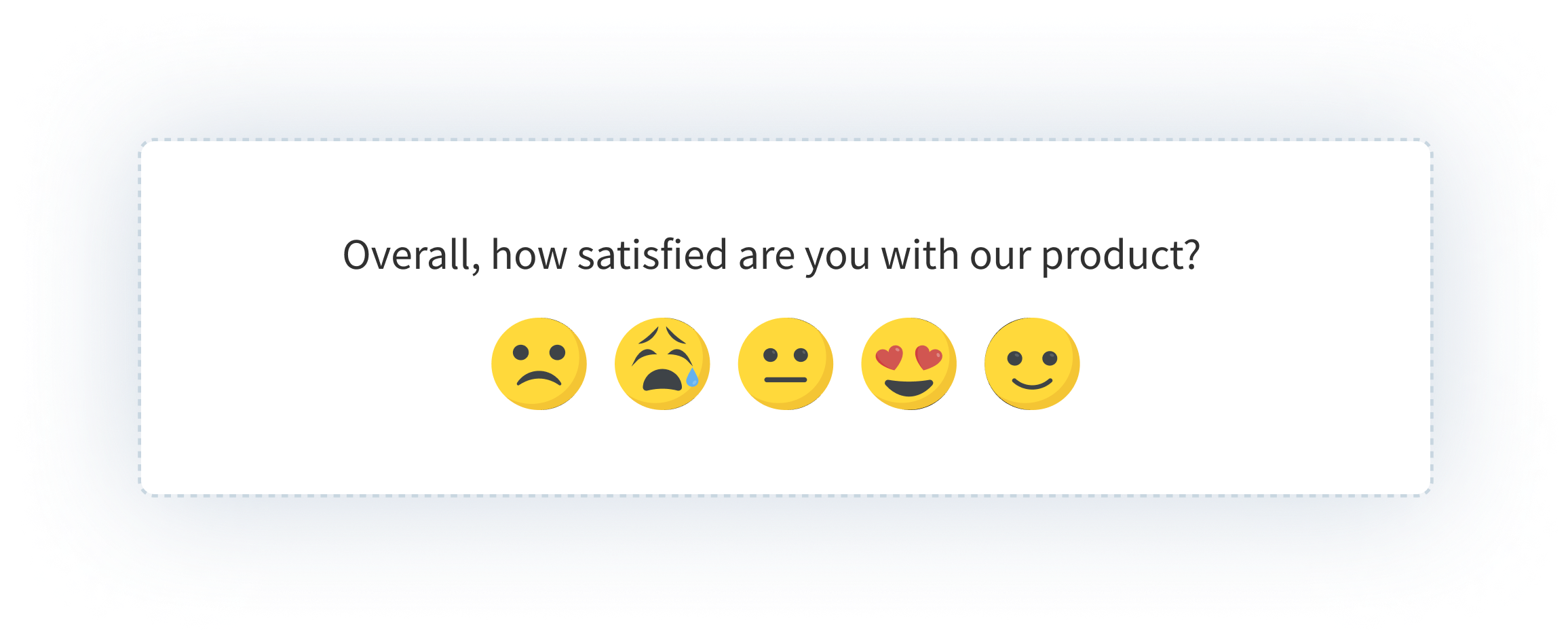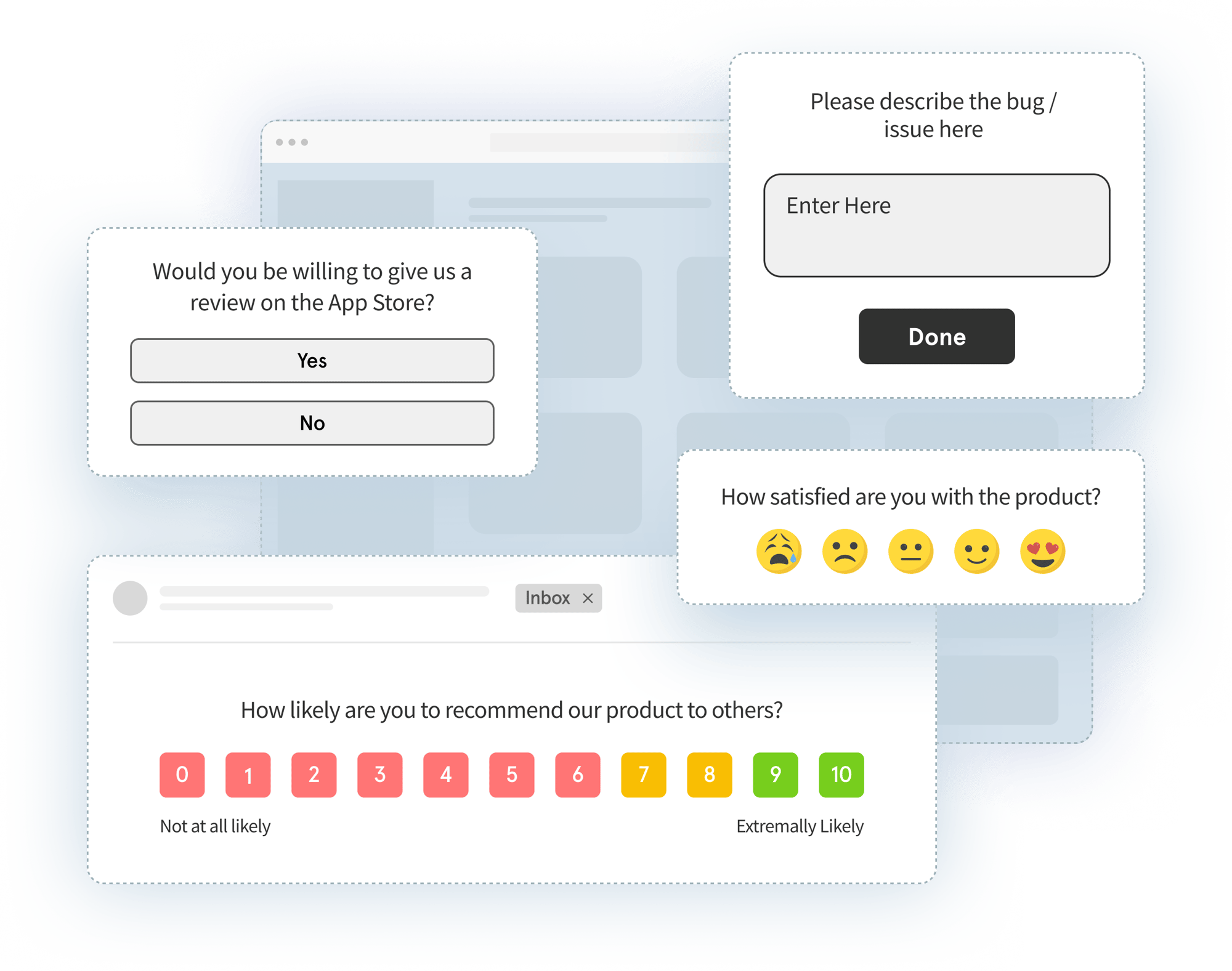Imagine this: your team has just launched a new product feature after months of development. The initial excitement is high, but as users start engaging with it, you notice something—they aren't using it the way you expected. Some are confused, others are frustrated, and a few simply abandon it. How do you fix it? How do you even know what’s gone wrong?
This is where product feedback tools come in!
They help you capture real-time insights from your users—whether it’s through feature feedback, beta testing, or post-launch surveys. Without them, you're flying blind, relying on guesswork instead of actionable data.
In this article, we’ll explore the best product feedback tools that not only gather feedback but also help you turn it into tangible improvements. These tools are essential for companies looking to stay agile, continuously refine their product, and ultimately, meet customer expectations.
TL;DR
-
Product feedback tools help you find out what users really like about your product and what they think could be improved.
- Based on key features, pros and cons, G2 ratings, and pricing, we’ve created a comprehensive list of the best product feedback tools to help you choose the right one for your business.
- Some of the best product feedback tools include Zonka Feedback, Canny, Sprig, WalkMe among others that can help you prioritize features, improve user experiences, and drive product growth.
- You can book a demo with Zonka Feedback to create product surveys, share them through different channels, and measure feedback so that your users would love the product you create.
Measure & Improve Product Experience
With Product Surveys, understand what users need and learn ways to delight your customers.

What is a Product Feedback Tool?
A product feedback tool is software that helps you collect, analyze, and act on real-time user feedback, providing insights directly from within your products. Whether through surveys, pop-ups, or in-app messaging, product feedback software allow product teams to make data-driven decisions that improve product features, user experience, and overall satisfaction.
💡Did you know that the origins of modern product feedback can be traced back to Toyota's "Kaizen" principle in the 1950s, where continuous improvement was driven by direct feedback from factory workers? This concept revolutionized manufacturing and is now widely adopted in product development, emphasizing the power of user input to refine and optimize processes.
Who Needs Product Feedback Tools—and Why?
At first glance, the answer seems obvious: any company building products. But not all teams within an organization require product feedback in the same way. Three key groups, however, can’t function effectively without it:
- Product Managers: They depend on product feedback tools to ensure their roadmap aligns with user needs. They use this data to prioritize features and make strategic decisions that shape the future of the product.
- UX & Design Teams: They rely on these tools to identify user pain points and optimize the overall experience. Continuous customer feedback helps them enhance usability and create frictionless product interactions.
- Marketing Teams: Insights from user feedback allow marketers to refine campaigns, align value propositions, and create content that reflects what users love (or struggle with) in the product.
- Customer Experience Teams: They use feedback to improve satisfaction by acting on user input. By closing the feedback loop, they show customers that their voices matter, which in turn increases loyalty and engagement.

But feedback is only valuable when it's collected strategically. For product leaders, the question isn't just 'how' to collect product feedback, but 'who' to collect it from:
- Power Users & Loyal Customers: They provide invaluable insights into feature performance and product strengths. Their feedback helps fine-tune the product and deepen engagement with your core audience.
- New Users: They are crucial for identifying gaps in your onboarding process and assessing whether your marketing accurately reflects the product’s value proposition.
- Churned Customers & Trial Users: They offer the most direct feedback on what’s not working. Understanding why these users disengaged or left helps prevent future churn and improve your product’s fit in the market.
Each of these customer segments provides unique insights, helping you fine-tune your product for different types of users and driving continuous improvement across the board.
Our Criteria for Choosing Best Product Feedback Software
In selecting the right product feedback tools, it’s crucial to consider how these tools serve different purposes across the product development lifecycle. Feedback is not one-size-fits-all, and neither are the tools used to collect it. By segmenting product feedback tools into categories, we aim to address the specific needs of product teams—from gathering in-context feedback to ideating new features and improving user experience through testing.
Here’s how we’ve categorized the tools and why:
- In-Product Feedback Tools: These tools (like Zonka Feedback, Survicate, Refiner, SatisMeter, and Qualaroo) are designed to capture real-time feedback directly from users as they interact with your product. They are essential for identifying user pain points, feature adoption, and overall satisfaction during actual product use.
- Product Ideas and Roadmaps: Tools like Canny, UserVoice, and ProductBoard help teams manage feature requests, prioritize ideas, and align roadmaps with user needs. These platforms streamline the process of gathering, voting on, and acting on user ideas to drive future product development.
- User Research and Testing Tools: Sprig, UserTesting, UserSnap, Userback, and Marker.io fall into this category. These tools are focused on deeper user research and testing, allowing teams to conduct usability studies, capture bug reports, and gain qualitative insights into how users engage with the product.
- Digital Adoption Platforms: Tools such as Pendo, WalkMe, and WhatFix help ensure users can easily adopt and navigate your product by providing in-app guidance and tutorials. These platforms are crucial for improving onboarding, user retention, and overall engagement.
Best Product Feedback Tools at a Glance
| Use Case | Product Feedback Tool | G2 Rating | Starting Price (Per Month) | Free Version |
| In-Product Feedback | Zonka Feedback | 4.7 | $49 | ❌ |
| Survicate | 4.6 | $107 | ❌ | |
| Refiner | 4.5 | $79 | ❌ | |
| Qualaroo | 4.3 | $19.99 | ✔️ | |
| SatisMeter | 4.8 | $199 | ✔️ | |
| Product Ideas & Roadmaps | Canny | 4.6 | $79 | ✔️ |
| UserVoice | 4.5 | $899 | ❌ | |
| Productboard | 4.3 | $19 | ✔️ | |
| User Research & Testing | Sprig | 4.6 | $175 | ✔️ |
| UserTesting | 4.5 | Not available | ❌ | |
| Usersnap | 4.6 | $42 | ❌ | |
| Userback | 4.8 | $4.9 | ❌ | |
| Marker.io | 4.8 | $39 | ❌ | |
| Digital Adoption | Pendo | 4.4 | Not available | ❌ |
| WalkMe | 4.5 | Not available | ❌ | |
| WhatFix | 4.6 | Not available | ❌ |
In-Product Feedback Tools
In-product feedback tools capture real-time insights during key user interactions, providing context-rich data through satisfaction surveys, feedback widgets, or pop-up surveys. They help you identify feature adoption, friction points, and areas for improvement—driving informed decisions and faster iteration without disrupting the user experience.
Let's explore the product feedback tools in this category.
1. Zonka Feedback: Comprehensive AI-Powdered Product Feedback Tool
Zonka Feedback stands out as an in-product feedback tool suitable across industries including SaaS and digital platforms that enables you to collect real-time, in-context user insights without disrupting the user experience. Through smart, non-intrusive microsurveys embedded within the web and mobile application, it allows you to capture feedback during key interactions, whether it's a user navigating through a new feature or encountering an issue to bring user insights into your product development.
For example, Futurehome used Zonka Feedback to boost their app rating from 2.9 to over 4.0 by gathering product feedback through customized surveys and addressing user concerns in real-time. By leveraging automated review redirection, they guided satisfied customers to app stores, transforming positive feedback into higher ratings and improving both their product and support.
The platform's intelligent survey triggering, combined with advanced user segmentation, ensures that feedback requests appear at the right time to the right users—based on behavior, device type, demographics, or specific touchpoints—delivering a seamless and highly relevant feedback journey. With powerful AI-driven insights like sentiment analysis and smart tagging, Zonka Feedback helps product teams identify friction points, monitor feature adoption, and optimize the overall user experience.
With its advanced automation, product teams can easily collect timely follow-ups and ensure faster closure of feedback loops. By simply pasting embed code snippets, you can easily integrate in-product surveys with website, in-app, email and shareable links and ensure feedback is captured from both in-app and external users for a comprehensive view of user satisfaction throughout the product journey.

Top Features
- Embed short, in-product microsurveys like NPS surveys, CSAT surveys, and CES surveys within your web or mobile app (iOS & Android) to capture real-time, contextual feedback from users
- Use 100+ customizable product survey templates, including beta testing survey template, mobile app feedback survey template, subscription cancellation survey template, etc.
- Target surveys with advanced user segmentation based on user behavior, demographics, or device for precise survey distribution
- Leverage AI-driven insights with sentiment analysis, automatic tagging, and response categorization to quickly identify trends and emotions
- Access real-time analytics and detailed insights on user behavior, feedback trends, and responses through an intuitive dashboard
- Expand feedback collection via email surveys, WhatsApp surveys, shareable links, website, in-app and feedback buttons to reach users both in and out of the product experience
- Set up email alerts and notifications to receive real-time updates on feedback or specific user triggers
- Integrate seamlessly with business tools like Salesforce, Zendesk, Freshdesk, and more to streamline feedback management and analysis
- G2 rating: 4.7/5
Zonka Feedback Pros
- Customizable microsurveys for seamless feedback collection
- Real-time, in-context feedback during product use
- Automation to streamline feedback collection and close feedback loops
- Advanced targeting and segmentation for specific user groups
- AI-driven sentiment analysis for deeper emotional insights
- Multichannel feedback collection via in-app, email, and links
Zonka Feedback Cons
While Zonka Feedback does offer API and third-party integrations (e.g., with Google Sheets and Twilio), complex product feedback setups may need technical expertise.
Zonka Feedback Pricing
- Paid plan starts at $49/month
Use If
You're seeking a powerful yet affordable, all-in-one product feedback solution that combines flexibility, collaboration, AI-powered insights, and advanced features like automation and detailed reporting. It’s ideal for product teams looking to streamline feedback collection, target specific user segments, and make data-driven decisions to enhance product experiences.
2. Survicate: Fast & Targeted In-Product Feedback Tool
Survicate is perfect if you're looking to quickly gather continuous feedback, streamline your product roadmap, and automate follow-up actions efficiently. Known for its simplicity, this product feedback software enables you to launch in-product microsurveys in minutes with just a few lines of code. Its key strength lies in its advanced targeting, allowing you to engage specific user groups at critical moments—whether you are identifying bugs or testing new features.
Additionally, its AI-powered survey creation and a wide range of integrations (like Mixpanel and Productboard) allow your product teams to streamline the entire product feedback process.

Top Features
- Capture real-time feedback with minimal disruption using pop-up surveys in web or mobile apps
- Collect user insights from specific groups based on behavior, demographics, or feature interaction with advanced targeting
- Build customized surveys quickly with an AI-assisted tool or from expertly designed templates
- Set up recurring surveys to track ongoing user satisfaction and feature performance
- Monitor survey results and track user trends with a comprehensive, real-time dashboard
- Connect with tools like Productboard, Mixpanel, and Slack to automate actions and streamline feedback
- G2 rating: 4.6/5
Survicate Pros
- Extremely fast setup with simple tracking code
- Advanced targeting for feedback relevance
- AI-powered survey builder for faster survey creation
- Recurring feedback capabilities to track ongoing product performance
- Seamless integration with popular tools for product management
Survicate Cons
- Limited visual customization for surveys
- Some integrations may require technical setup for optimal performance
Survicate Pricing
- Paid plan starts at $107/month
- Free trial for 10-days available
- Free version not available
Use If
You need an easy-to-implement product feedback tool that offers real-time, in-product insights. Ideal for teams focused on testing new features, gathering user sentiment, and refining product experiences with advanced targeting and minimal setup effort.
3. Refiner: Customizable In-Product Feedback Tool
Refiner is designed for SaaS and web-based companies, offering highly customizable in-product microsurveys to capture real-time feedback within web and mobile apps. With advanced user targeting, you can engage specific user segments at critical moments, gathering valuable insights on product usage, satisfaction, and feature adoption.
With Refiner, product teams can measure PMF, churn, engagement, and conversion, while marketing and customer success teams collect reviews, monitor NPS, CSAT, CES, and address churn. Its seamless integrations with leading product tools combined with in-depth insights, ensure data-driven decisions and identify growth opportunities.

Top Features
- Capture real-time feedback with fully branded, tailored surveys for web and mobile apps with customizable in-product microsurveys
- Engage specific user segments at key moments, triggered by behavior or product interaction with advanced user targeting
- Seamlessly sync feedback with tools like Segment, Mixpanel, and Zapier to streamline data flow
- Measure customer satisfaction, loyalty, and effort directly within your app with NPS, CSAT, CES surveys
- Set up recurring surveys to track user satisfaction and feature performance over time
- Analyze detailed feedback with in-depth insights and analytics
- G2 rating: 4.5/5
Refiner Pros
- Strong focus on SaaS and digital product needs
- Highly customizable surveys that fit your brand’s look and feel
- Advanced targeting to collect feedback from most relevant users
Refiner Cons
- Not as feature-rich for non-digital or non-SaaS industries
- May require technical expertise for more advanced integrations
- Limited visual customization for surveys
Refiner Pricing
- Paid plan starts at $79/month
- Free trial available
- Free version not available
Use If
You're a SaaS or web-based platform needing a simple, targeted in-product software with advanced user targeting and seamless integration into your data and product tools. Perfect for small to medium-sized businesses with focused survey needs.
4. Qualaroo (Now ProProfs): Mobile & Web Focused Product Feedback Tool
Qualaroo, now part of ProProfs, is a customer feedback tool that offers customizable microsurvey prompts called 'Nudges' engage users at key moments to gather insights on product usage, satisfaction, and user intent. Tailored for web and mobile product teams, Qualaroo’s AI-powered analytics (powered by IBM Watson) offers deep sentiment analysis, automatically categorizing feedback and spotting trends. With advanced targeting, you can show surveys based on user behavior, making feedback both contextual and actionable.
Its seamless integration with CRMs and project management tools ensures quick action on insights, while prototype testing features help validate product changes early on.

Top Features
- Collect feedback in real time with fully branded, non-intrusive customizable microsurveys on web and mobile apps
- Trigger surveys based on user behavior, page visits, time spent, and more to capture precise insights
- Leverage AI insights powered by IBM Watson to analyze sentiment, identify key themes, and categorize feedback
- Collect feedback on product prototypes during the development phase for early validation
- Connect with CRMs and project management tools to streamline actions based on feedback
- G2 rating: 4.3
Qualaroo Pros
- Strong focus on in-product feedback for web and mobile apps
- Advanced user targeting for highly relevant feedback
- AI-driven sentiment analysis provides deeper insights
- Quick, lightweight installation with no impact on site performance
Qualaroo Cons
- Limited integrations compared to competitors
- No support for email surveys or feedback from users who have abandoned the app
- White-labeling costs extra
Qualaroo Pricing
- Paid plan starts at $19.99/month
- Free trial available
- Free version available
Use If
You need an in-product feedback tool for capturing real-time insights from website and mobile app users, with advanced targeting and AI-driven analytics.
5. SatisMeter: Real-Time Feedback Solution for Web & Mobile App Optimization
SatisMeter is popular among customer feedback tools for web and mobile platforms as it integrates directly into your product to gather feedback at critical touchpoints, enabling you to measure product-market fit and feature usage. With event-triggered surveys and advanced targeting, product teams can capture the right feedback when it matters most, all while integrating responses into their tech stack with ease. Its strength lies in its seamless integration with tools like Productboard, Segment, and Slack, ensuring feedback reaches the right team in real-time.
Whether you’re tracking NPS, CSAT, or CES, or conducting product research, this product feedback software offers a simple yet powerful solution to drive data-driven decisions and improve the product experience.

Top Features
- Easily gather feedback from users while they interact with your web or mobile app with in-product microsurveys
- Collect feedback at key moments, such as feature launches or specific user behaviors with event triggered surveys
- Seamlessly integrate feedback with tools like Productboard, Segment, Slack, and Zapier for streamlined workflows
- Track customer satisfaction metrics like NPS, CSAT & CES directly within the app to drive product decisions
- G2 rating: 4.8/5
SatisMeter Pros
- Easy to set up and seamless integration
- Event-triggered and contextual surveys
SatisMeter Cons
- Limited customization options for visual design
- Requires additional setup for more complex feedback workflows
- Unlimited surveys and users in all plans, making it ideal for scaling teams
SatisMeter Pricing
- Paid plan starts at $199/month
- Free version available
Use If
You are a small to mid-sized SaaS businesses looking for easy to setup, flexible and scalable solution to gather product feedback without heavy technical demands.
Product Ideas & Roadmaps Software
Product ideas and roadmap tools centralize feature requests and user suggestions, helping you prioritize development based on user needs and business goals. These tools align cross-functional teams, track progress, and create transparent, data-driven roadmaps, ensuring strategic product decisions and fostering collaboration.
Let’s explore the top tools in this category that turn ideas into actionable roadmaps.
6. Canny: Centralized Product Ideas & Roadmap Management Tool
Canny is a product feedback and feature request management tool that empowers your product team to capture, organize, and prioritize feature requests with ease. Its intuitive voting board lets your users weigh in on desired features, giving you clear insights into what your customers truly want. By consolidating feedback from various sources, Canny helps you prioritize features based on user demand and business goals, ensuring your roadmap is aligned with real needs.
You can also close the feedback loop automatically—users are notified as soon as their requested feature goes live. With seamless integrations into project management tools, Canny makes it simple to streamline your feedback process and keep your product development on track.

Top Features
- Collect votes on feature requests from users to prioritize development based on demand
- Organize feedback from multiple sources (e.g., customer chats, reviews) into one tool
- Notify users when requested features are completed, closing the feedback loop automatically
- Build public or private roadmaps to share progress with both users and teams
- Connect with tools like Jira, Asana, Slack, and more to integrate feedback into your development process
- G2 rating: 4.6/5
Canny Pros
- Intuitive feature voting system
- Seamless integration with project management tools
- Automatic updates to users when a feature request is completed
- Centralized feedback from multiple channels into one place for easy analysis
Canny Cons
- Limited customization options for the voting board’s design
- Analytics and reporting features are less detailed
Canny Pricing
- Paid plan starts at $79/month
- Free version available
Use If
You are looking for a product feedback tool with voting board solution and want to build transparent, data-driven roadmaps that align with both user needs and business goals.
7. UserVoice: Product Feedback Software for Continuous Product Discovery
UserVoice helps you turn real-time user feedback into actionable insights, guiding your product roadmap with confidence. Through in-app feedback widgets, you can capture feedback from users at key moments, giving your product teams a deeper understanding of feature prioritization and user pain points. Its continuous product discovery framework allows you to actively involve users in the product development process, ensuring that feedback never falls into a "black hole."
With powerful analytics and seamless integrations, you can transform user insights into actionable steps and foster a customer-first approach to product evolution.

Top Features
- Collect real-time user feedback directly within your product to capture context-rich insights with in-app feedback widgets
- Consolidate feedback across various channels to create a clear view of customer needs
- Use actionable feedback insights to prioritize and guide your product roadmap
- Keep the feedback cycle ongoing with tools that allow for constant user input and product iteration
- Connect with your existing tools to streamline feedback analysis and share insights across teams
- G2 rating: 4.5/5
UserVoice Pros
- Continuous discovery keeps user needs central to product decisions
- In-app widgets enable seamless, timely feedback collection during product use
- Centralized feedback helps teams align on priorities
- Strong integrations streamline workflows and quicken action
UserVoice Cons
- Limited customization options for feedback widgets
- Limited advanced analytics
UserVoice Pricing
- Paid plan starts at $899/month
- Free version not available
Use If
You are looking for a powerful product feedback software to engage users directly within your product, prioritize their needs, and keep feedback loops active for ongoing product discovery and improvement.
8. ProductBoard: Product Feedback Software for Data-Driven Insights
Productboard stands out with its ability in organizing product ideas, prioritizing features, and visualizing dependencies, all while ensuring that every stakeholder is aligned. With customizable templates and interactive roadmaps, you can easily share progress with your team, keeping everyone updated on shifting priorities.
By consolidating insights and pushing prioritized features into development tools, Productboard streamlines your roadmap, ensuring product decisions align with user needs and business goals. It’s a must-have for product managers balancing long-term vision with immediate development milestones.

Top Features
- Create interactive, always up-to-date roadmaps that automatically adapt to changes
- Organize and prioritize features based on user feedback and business impact
- Share roadmaps with teams and stakeholders to keep everyone aligned on progress
- Sync features with development platforms like Jira, ensuring seamless workflow and progress tracking
- Visualize and manage dependencies to avoid delays and ensure smooth product development
- G2 rating: 4.3/5
ProductBoard Pros
- Dynamic roadmaps keep stakeholders updated in real time
- Strong prioritization features based on data driven insights
- Clear visualization of dependencies to prevent bottlenecks
ProductBoard Cons
- Learning curve required with the roadmap customization
- Limited flexibility in how user feedback is displayed
ProductBoard Pricing
- Paid plan starts at $19/maker/month
- Free version available
Use If
It’s ideal for mid to large-sized businesses looking to collaborate across departments, manage dependencies, and ensure strategic alignment. It is most effective for teams managing complex product development cycles that require continuous prioritization.
User Research & Testing Product Feedback Software
User research and testing tools offer valuable insights into user behavior, helping your product team validate concepts and improve user experiences. Through methods like usability testing, surveys, and live feedback, these tools identify friction points and gather real-world data before scaling product changes.
Let’s explore the product feedback tools in this category.
9. Sprig: AI-Powered User Research Tool for Product Teams
Sprig is designed to help product teams gain in-depth insights into user behavior, enabling data-driven decisions that drive product improvements. Its unique ability to combine video clips of user behavior with survey feedback helps product teams identify issues, test new ideas, and refine the user experience without guesswork.
The AI recommendations analyze user interactions and feedback to offer actionable insights that guide product development. This continuous stream of insights not only identifies where users get stuck but also offers solutions for improving product adoption, satisfaction, and retention.

Top Features
- Capture and analyze user behavior through targeted video clips to identify key issues
- Visualize where users interact most with your product and uncover friction points with heatmaps
- Launch in-product surveys and watch AI analyze results in real time for instant feedback
- Generate product insights based on user actions and feedback with AI recommendation
- Integrates with analytics tools like Mixpanel and Amplitude for seamless data flow
- Run ongoing tests and gather data to continuously refine and improve the product experience
- G2 rating: 4.6/5
Sprig Pros
- Provides deep user behavior insights by combining replays and feedback
- AI recommendations make it easy to act on research findings
- Real-time testing allows for continuous product iteration
Sprig Cons
- Learning curve required when configuring AI features
- Limited customization for survey design
Sprig Pricing
- Paid plan starts at $175/month
- Free version available
Use If
You need a powerful user research and testing platform that links real-time behavior analysis with feedback to improve product experience.
10. UserTesting: Video-Powered User Research & Testing Tool
UserTesting enables product teams to dive deep into user behavior by watching real users interact with your product or prototype. Its core strength lies in live usability testing, customer interviews, and card sorting, allowing you to observe firsthand how users navigate your product and identify friction points. With the ability to conduct live interviews and gather real-time user feedback, this product feedback tools helps product teams validate ideas, test prototypes, and optimize user experiences based on real human insights.
It also centralizes research data, from recorded sessions to user feedback, into a single platform. This makes it easy to organize, share, and analyze product feedback findings across teams, ensuring that everyone is aligned with the user experience.

Top Features
- Conduct real-time user testing sessions to observe interactions and identify usability issues
- Watch recorded sessions of users navigating your product to gain firsthand insight into their behavior
- Collect in-depth qualitative data through user interviews and surveys for a complete understanding of user needs
- Organize and share user research, testing videos, and feedback in one place for easier collaboration
- Analyze trends and patterns in user behavior to improve product features and design
- G2 rating: 4.5/5
UserTesting Pros
- High-quality insights through direct observation of user interactions
- Flexible research methods, including usability tests, card sorting, and interviews
- Quick turnaround for testing results, enabling faster decision-making
UserTesting Cons
- Can be expensive for smaller teams
- Interface can be complex, leading to a learning curve for new users
UserTesting Pricing
- Contact sales team for pricing information
- Free version not available
Use If
You're looking for a powerful user research platform to observe real-time interactions and collect feedback. Ideal for mid to large-sized product teams for usability testing and live interviews to refine product features and prototypes.
11. Usersnap: Simplified User Research Product Feedback Tool
Usersnap makes it easy to gather real-time, in-product feedback through customizable micro surveys, screen recordings, and screenshots. Designed for product teams focused on user research and testing, it allows you to capture insights as users interact with your product. You can leverage its targeted feedback collection methods, customizable design, and easy bug reporting to streamline processes and make data-driven decisions.
Whether it's measuring satisfaction with CSAT and NPS or resolving issues with clear, actionable insights, Usersnap ensures a continuous loop of product improvement based on real user input.

Top Features
- Collect real-time feedback from users directly within your product with customizable widgets
- Capture clear visual insights to understand user issues and track bugs with screen recording and screenshot feedback
- Tailor product feedback forms to your brand and show them to the right users at the right time
- Measure user satisfaction using CX metric surveys with built-in sentiment analysis feature
- Integrate with tools like Jira, Asana, Slack, and more to streamline feedback management
- Get alerts and feedback instantly to improve collaboration and response time with real-time notifications and alerts
- G2 rating: 4.6/5
Usersnap Pros
- Easy setup with minimal coding for feedback collection
- Clear visual feedback through screen recordings and screenshots
- Seamless integrations with popular project management tools
Usersnap Cons
- Interface could be more intuitive
- Limited advanced analytics
Usersnap Pricing
- Paid plan starts at $42/month
- Free trial available
- Free version not available
Use If
You have small to mid sized team and are seeking a flexible product feedback tool that captures real-time user insights and resolves bugs through visual feedback.
12. Userback: User Research Product Feedback Tool for Web Apps
Userback empowers your product teams to capture and analyze real-time user feedback through interactive features like targeted surveys, annotated screenshots, and session replays. This gives product leaders and managers a clear view of user needs, helps uncover valuable feature requests, and spot pain points as users interact with your product.
With visual feedback tools like in-app surveys and bug reporting, you can quickly take action to improve the user experience and drive product success. Centralizing all feedback into a single platform, Userback makes it easy to manage, track, and prioritize user insights.

Top Features
- Gather real-time feedback via in-app surveys and widgets to quickly understand user needs and feature ideas
- Use annotated screenshots and session replays to help developers quickly resolve issues
- Capture detailed bug reports directly from users for faster resolution
- Consolidate all user feedback into one platform, simplifying management and prioritization
- Personalize widgets to capture specific insights without disrupting the user experience
- Sync feedback with popular tools like Jira, Slack, and Trello for streamlined collaboration
- Customize feedback workflows with a powerful REST API for seamless integration into your existing tech stack
- G2 rating: 4.8/5
Userback Pros
- Easy-to-use visual feedback features
- Customizable widgets to gather relevant insights
- Seamless integration with popular project management tools
Userback Cons
- Limited advanced analytics for deep data-driven insights
- Requires technical setup for more complex integrations and customizations
Userback Pricing
- Paid plan starts at $49/month
- Free trial available
- Free version not available
Use If
You’re seeking an easy-to-use product feedback platform to collect and manage real-time product feedback with visual context, helping you improve UX, resolve bugs, and efficiently prioritize feature development.
13. Marker.io: Bug Reporting & Visual Feedback Tool
Marker.io is designed to streamline feedback collection from users, clients, and team members, making it easier to identify bugs, understand user behavior, and gather actionable insights. With its in-app widget, Marker.io enables users to submit feedback with annotated screenshots, session replays, and technical metadata, giving product teams a clear picture of the issues users face in real-time.
This product feedback tool is particularly useful for product teams and developers looking to accelerate their bug resolution process, track user behavior, and manage valuable customer feedback efficiently, all while reducing the back-and-forth communication often involved in bug reporting.

Top Features
- Users can annotate screenshots, provide comments, and use emojis to deliver clear feedback
- Watch recordings of user sessions to understand exactly how bugs or issues occurred
- Automatically captures technical details like URL, browser, OS, and more, helping developers reproduce and fix bugs faster
- Tailor product feedback forms to fit the needs of both internal teams and external users, from simple bug reports to detailed QA forms
- Seamlessly integrates with tools like Jira, Trello, GitHub, and more, ensuring feedback is sent directly to your project management system
- G2 rating: 4.8/5
Marker.io Pros
- Easy-to-use for both technical and non-technical users
- Detailed technical metadata included in every bug report
- Session replay feature to see the exact customer journey
Marker.io Cons
- Limited customizability in feedback forms for advanced use cases
- Insufficient session replay length for longer user journeys
Marker.io Pricing
- Paid plan starts at $39/month
- Free trial available
- Free version not available
Use If
You need an efficient, visual feedback tool that helps product teams and developers resolve bugs faster and prioritize product improvements with real-time, actionable insights. Ideal for digital agencies, SaaS product teams, and QA testers.
Digital Adoption Product Feedback Tools
Digital adoption platforms improve product onboarding and feature adoption by offering real-time guidance within your product's interface. These tools help you boost user engagement, reduce churn, and enhance satisfaction by delivering personalized, in-app experiences and self-service support, ensuring users can easily navigate and maximize the product’s value.
Let’s explore the product feedback tools in this category.
14. Pendo: Data-Driven Product Adoption Platform
Pendo is a powerful digital adoption platform designed to help product teams enhance user experiences and drive product adoption. With Pendo, you can track user behavior to understand which features are being used, ignored, or causing friction. By leveraging these insights, product teams can create in-app guides and personalized messages—without the need for coding—that streamline the onboarding process, increase feature adoption, and provide real-time support to users.
Its analytics and in-app feedback empower you to capture and prioritize feature requests, helping build better products aligned with customer needs. This makes it a go-to tool for product teams looking to improve retention, reduce churn, and boost customer satisfaction.

Top Features
- Track feature usage, adoption, and customer engagement to guide your product decisions
- Create personalized, no-code guides and product surveys to increase user onboarding and gather real-time feedback
- Group users based on behavior and target them with relevant surveys to improve response rates
- Use feedback data to prioritize feature development based on customer needs and upvotes
- Connect with tools like JIRA, Salesforce, Zendesk, and HubSpot to streamline feedback and product development workflows
- G2 rating: 4.4/5
Pendo Pros
- Simple in-app guides and walkthroughs for better onboarding and feature adoption
- Real-time feedback collection to assess feature performance
- Advanced segmentation for precise targeting
Pendo Cons
- In-app guides can slow down performance with larger applications
- Limited customization options for feedback forms
- Analytics may require training to fully utilize
Pendo Pricing
- Contact sales team for pricing information
- Free trial available
- Free version not available
Use If
You’re a mid-sized to enterprise-level business looking to improve digital adoption by optimizing user onboarding, driving feature adoption, and building data-driven roadmaps.
15. WalkMe: AI-Powered Digital Adoption Tool
WalkMe is a pioneering digital adoption platform designed to enhance software adoption, streamline workflows, and improve user experiences. With WalkMe, product teams gain full visibility into how users interact with their software, identify areas where users experience friction, and provide personalized, in-the-moment guidance. Its AI-powered insights help teams take immediate action to resolve issues, optimize workflows, and ensure users are leveraging the full potential of the software.
Whether it’s for onboarding new users, guiding employees through complex processes, or automating routine tasks, WalkMe integrates seamlessly with your tech stack to deliver real-time insights and improve software adoption, ultimately maximizing ROI.

Top Features
- Automate user assistance and deliver personalized in-app guidance at points of friction with AI
- Monitor software usage and user interactions to understand how workflows perform across your organization
- Create and deploy in-app tutorials, walkthroughs, and help without the need for coding
- Segment users based on behaviors and provide tailored guidance to improve product adoption
- Adapt to new software or process changes with built-in tools for user support and adoption tracking
- Works on desktop, mobile, and web applications, ensuring users are guided wherever they are
- G2 rating: 4.5/5
WalkMe Pros
- Easy-to-use no-code setup for creating in-app guides
- AI-powered guidance helps reduce support tickets
- Customizable automation tools for complex workflows
WalkMe Cons
- Steep learning curve for complex customizations
- Slower performance with large applications
WalkMe Pricing
- Contact sales team for pricing information
- Free version and free trial not available
Use If
You’re a mid-sized to enterprise-level business looking to improve digital adoption by optimizing user onboarding, driving feature adoption, and building data-driven roadmaps.
16. WhatFix: No-Code Digital Adoption Solution
Whatfix empowers you to drive user productivity and maximize the ROI of digital investments by providing seamless in-app guidance, personalized user support, and actionable analytics across web, desktop, and mobile applications. Leveraging GenAI, it helps users navigate complex software and workflows with ease, enabling product teams to improve feature discovery, process compliance, and user experience.
With no-code analytics and interactive in-app tools like task lists, smart tips, and pop-ups, Whatfix ensures users are supported in the flow of work, reducing support costs and boosting productivity.

Top Features
- Offer step-by-step assistance via Flows, Task Lists, Smart Tips, and Pop-Ups to guide users through complex applications
- Enable users to access on-demand help, tutorials, and product support directly within the application
- Track user engagement and feature adoption without needing technical skills, ensuring data-driven insights
- Provide hands-on training experiences using simulated environments for improved user onboarding and upskilling
- Works across web, desktop, and mobile apps for a consistent user experience
- G2 rating: 4.6/5
WhatFix Pros
- In-app guidance helps reduce user confusion and support tickets
- No-code setup for analytics and custom workflows
- Personalized training and support for high user adoption
- Strong focus on process compliance and feature discovery
WhatFix Cons
- Initial implementation can be challenging
- Slower performance with large applications
WhatFix Pricing
- Contact sales team for pricing information
- Free version and free trial not available
Use If
You are a medium to large enterprise undergoing digital transformation or managing complex software environments and want to boost user productivity, reduce support costs, and ensure seamless software adoption.
Conclusion
Choosing an effective and comprehensive product feedback tool can become tricky. The key is to first ensure the most important features in the tools you shortlist and then decide further as per your budget and business requirements. Whether you’re just beginning your product feedback journey or looking to enhance your current processes, the product feedback tools discussed in this article would provide valuable insights to help you stay ahead.
If you're looking for a powerful, user-friendly solution that seamlessly integrates with your product and team, Zonka Feedback offers useful features like advanced user segmentation, AI text analysis, advanced reporting and analysis and much more that can help you improve your product.
Ready to elevate your feedback strategy? Schedule a demo with Zonka Feedback and turn feedback into growth!









.jpg)
